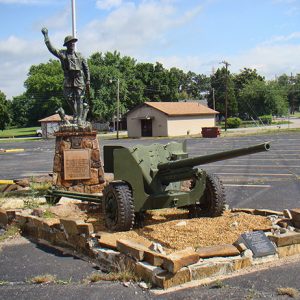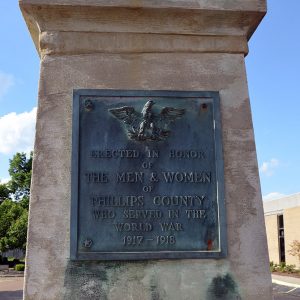calsfoundation@cals.org
Spirit of the American Doughboy Monuments
The Spirit of the American Doughboy Monuments in Helena-West Helena (Phillips County) and Fort Smith (Sebastian County) are memorial sculptures erected following World War I to honor Arkansas servicemen who fought and died in the war.
The Arkansas statues were dedicated as part of a nationwide series of Doughboy sculptures designed by artist E. M. “Dick” Viquesney. At least 136 Viquesney Doughboys survive in thirty-five U.S. states, and some experts consider the Doughboy to be one of the most-seen pieces of outdoor statuary in the nation. Viquesney, who lived from 1876 to 1946, devoted two years to perfecting what was to become his trademark. He interviewed scores of World War I veterans, studied hundreds of photographs, and used two soldiers as live models. Viquesney’s Doughboy monument, which was named the official World War I National Memorial, became extremely popular and was erected across America until the late 1930s.
The first Spirit of the American Doughboy Monument in Arkansas was placed by an organization whose roots lay in the commemoration of the Civil War. The Phillips County Memorial Association was one of many ladies’ memorial associations formed throughout the former Confederacy soon after the war to gather the remains of the Southern dead and mourn their passing. Unlike many memorial associations, which sought primarily to commemorate the Confederate dead, the Phillips County Memorial Association set its sights on commemorating the casualties of another war by raising money for a World War I memorial on Cherry Street in downtown Helena. Helena’s monument, which honored the men and women of Phillips County who served in World War I, was the culmination of nine years of work by the association, aided by the Seven Generals Chapter of the United Daughters of the Confederacy. It was financed through donations from Phillips County residents, but progress was slowed by factors beyond the association’s control. The Helena World explained that “there have been droughts and floods and boll weevils and cotton worms and financial deflations during the nine years in which the Memorial Association has sought its goal, and all these have helped to retard the movement.”
On July 10, 1927, the Spirit of the American Doughboy monument was dedicated before a crowd of 2,500. The program began with the Marianna (Lee County) military band marching down Cherry Street. The featured speaker was Senator Joe T. Robinson, who recalled his 1917 Senate vote in favor of war and praised the men and women who responded to the call to arms. Seven young girls, representing the towns of the county, removed the curtain to reveal the completed statue. After the festivities, the monument was lit with a special floodlight. Located adjacent to the Phillips County Courthouse, the monument was listed on the National Register of Historic Places on May 23, 1997.
Arkansas’s second Spirit of the American Doughboy, located across the state in Fort Smith, was sponsored by a group with roots in World War I: the American Legion. The Fort Smith American Legion post was named after Victor Ellig, the first Fort Smith soldier to die in the war, who was shot through the heart by a German sniper while advancing on an enemy position on July 22, 1918. The Ellig post was always heavily involved with creating and promoting parks and playgrounds in Fort Smith. In 1928, Post No. 31 Commander Henry Armstrong was named permanent chairman of the city’s parks and playgrounds commission. A committee was formed then, “investigating the immediate needs of Lewis Tilles children’s park,” and the post began a drive to install a World War I memorial at Tilles Park. In April 1930, the Arkansas Legionnaire announced that the city park board would pay $500 of the $1,000 necessary to build the bronze Doughboy statue at the entrance to the park.
At the dedication on July 4, 1930, more than 2,000 people gathered at Tilles Park for a ceremony that included “the unveiling and dedication of ‘The Spirit of the American Doughboy,’ the first night tennis match ever held in the city, and a band concert.” Victor Ellig’s parents and several Gold Star mothers were in attendance. Dr. W. R. Brooksher, who led the committee that since 1928 had worked to acquire a World War I memorial, presented the statue to Victor Ellig Post No. 31 Commander John Coley, who in turn presented it to Henry Armstrong of the parks and playgrounds commission. Armstrong then formally presented the monument to Mayor Fagan Bourland. The statue was unveiled by “two little misses,” Jo Ann Carroll and Nancy Mae Connor.
The Fort Smith monument remained in Tilles Park for half a century but was warehoused by the city after frequent vandalism, including the destruction of the figure’s rifle. It was restored and placed in front of the Legion building at 4901 Midland Boulevard in Fort Smith around 1989, and listed on the National Register of Historic Places on May 23, 1997.
For additional information:
“Doughboy Is Unveiled at Big Program. Helena World, July 11, 1927, p. 1.
“Fort Smith Has Big City Program.” Arkansas Legionnaire, March 1, 1930, p. 1.
Griffee, John. “Doughboy Statue to be Dedicated at Park: Town Is Quiet as Observance of Day Is Held.” Fort Smith Times Record, July 4, 1930, p. 1.
———. “War Memorial Given to City by Post.” Fort Smith Times Record, July 5, 1930, p. 1.
Phillips County Historical Society. Historic Helena-West Helena, Arkansas. 2nd edition, Helena, AR: 1978.
“Spirit of the American Doughboy Statue Erected Here.” Helena World, July 19, 1927, p. 8.
“Spirit of the American Doughboy Monument (Fort Smith).” National Register of Historic Places nomination form. On file at Arkansas Historic Preservation Program, Little Rock, Arkansas.
“Spirit of the American Doughboy Monument (Helena).” National Register of Historic Places nomination form. On file at Arkansas Historic Preservation Program, Little Rock, Arkansas. Online at https://www.arkansasheritage.com/docs/default-source/national-registry/ph0260s-nr.pdf?sfvrsn=89b8af10_0 (accessed November 21, 2025).
Mark K. Christ
Arkansas Historic Preservation Program









Comments
No comments on this entry yet.